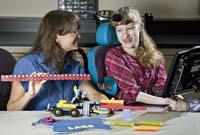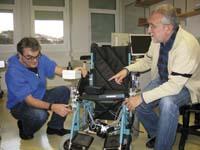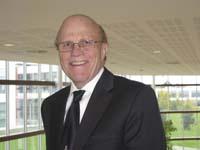Above disabilities, towards personal autonomy

"Technology must be a great ally for people with disabilities, but to do this we must continue working in the field of universal design: designing products and environments that all people can use without the need for other adaptations and specialized designs." These are the words of Dr. Albert Cook, who gave a lecture in San Sebastian.
Cook is a professor of Pathology and Language Audiology at the Faculty of Medicine and Rehabilitation at the University of Alberta (Canada). Last November, a conference was held in the Technological Park of San Sebastian on communication systems for people who, temporarily or permanently, do not have access to the voice, on "New approaches in the field of R&D technology supporting Augmentative and Alternative Communication". The second guest of the event was the electronic engineer Luis Azevedo, of the Technical University of Lisbon, who spoke about the healthcare technologies of the hospital for expandable communication.
Both have a direct relationship with people with disabilities and presented examples of devices that help these types of people in some tasks or day to day: some are sophisticated and others simpler.
There are intelligent ear devices (which adapt the volume according to the noise of the medium), as well as cochlea implants for the deaf: an operation applies a device in the ear to facilitate the functions of the cochlea; the implant receives acoustic signals and converts them into electrical signals that excite the auditory nerve; the latter are sent to the brain as a nerve impulse.
They also mentioned the Eye Tracking system (which consists of selecting the components with a look on a screen) and small laptops for children with intellectual disabilities, based on a context known to the child, and on the screen are shown different places in images (school, restaurant, park…) so that you can express your preferences. Methods that convert texts into voice, systems based on pictograms (each pictogram can have more than one meaning and the meaning is determined by the sum of icons)... Many of these support devices are accessible on the market and others are still in development.
It is known that these systems have opened new doors for people with communicative disabilities. But, in addition to the importance of continuing to develop them, two experts highlighted the importance of always betting on design for all.
Help or barrier?
"The main Information and Communication Technologies (ICT) offer people with disabilities great advantages: they contact other people, offer access to education and employment and, in general, contribute to the social participation of people with disabilities. The issue is that the main problem is access to people with disabilities who are going to use ICTs; obstacles are technological," Cooke said.
Those with motor problems, for example, find it difficult to use keyboard, mouse and other input methods, and even more difficult are small mobile keyboards and laptops. Vision problems require larger screens or alternative formats (Braille, voice output...). And in the case of those who have cognitive limitations, you also have to improve: "they need non-complex interfaces for users, who do not have many information paths or who at the same time do not require attention in the different areas of the screen."
If all of this is not improved, Cook believes that ICTs can be more an obstacle than an aid. He says that if they have to meet everyone's needs, they have to be accessible to everyone, easy to adapt for many disabilities and abilities. Otherwise, instead of contributing to the integration of people with disabilities, the opposite can be achieved: increasing the difference between them and the rest of the population.
For years the concept of universal accessibility has been reinforced not only in urbanism, but also in informatics. Also present, for example, are those of the Laboratory of Human-Computer Interaction for Special Needs (BBPKEL) of the UPV.

BBPKEL, 25 years working
The laboratory was created by three UPV professors 25 years ago on the campus of Donostia. "We wanted to investigate, but computing itself seemed too technological; we wanted to do something more human," recalled Julio Abascal, founder of the laboratory and current director. To address the communication problems of people with disabilities, work began on the application of new information technologies.
Since then a series of devices have been developed primarily for people with difficulty speaking, moving and manipulating (controlling the environment). In recent years they have expanded their scope of application and have designed person-computer interfaces for all types of special needs. The Group has designed programs to support direct and remote communication between people (through accessible telecommunications systems), environment control systems, simulation software and evaluation of various input/output systems and portable communication devices, among others.
As researcher Nestor Garay explains, "in the beginning several devices were manufactured in the laboratory, combining hardware and software, but now it is much easier to take a standard device and adapt it, or make applications adapted to existing devices, incorporating the corresponding interfaces or technical assistances." "So it is," says Abascalek--. We made several à la carte devices, but then we saw that formalization and theorization and design were better for everyone."
"Different and complementary"
LPC therefore prioritizes research related to universal accessibility. "A broad line of research refers to web accessibility, in which one cannot think of a single recipient," says Garayk--. Several projects and doctoral theses have emerged: blind, deaf, with motor problems... it is difficult to determine the recipient, in addition to combinations. The user can be any and that we call universal accessibility. We want to design so that everyone has all the options, without obstacles. Each person is different, in disabilities and capacities, and we should not try to set limits, limits are created by themselves or preceded."
Abascal indicates that it is necessary to distinguish between systems accessible to all (“beneficial to all”) and support technologies or special devices. "We work on two sides. Despite having a guarantee designed for everyone, two things are often needed. On websites it is very clear that a blind person, for example, needs a screen reader. But despite having a special device, if there was an image on the screen without comments, he could not know what is there. If you don't design it for everyone, help devices are useless. They are two different and complementary things between them."
This coincides with the main lines of current research. And that makes collaboration possible. In the case of the LPC, in addition to other members of the UPV, they have collaborated in Spain, Italy, Belgium, Germany or the USA. "The situation has changed a lot," says Abascalek-. 25 years ago this field of computing was not recognized as a scientific field, now yes. Awareness has also improved." Examples of this are the specialized publications and congresses that have been published over the years: "Conferences like Miramon serve to see how others work to learn new techniques and experiences. And it gives us time to expand our own, and perhaps also to collaborate."






